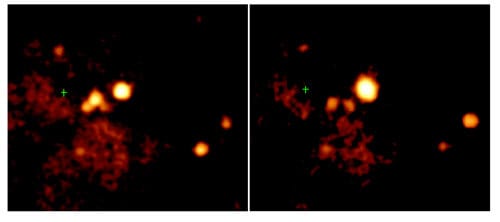Astrophysicists in the US may have found a "medium-sized" black hole in a nearby starburst galaxy called M82. Philip Kaaret and colleagues at the University of Iowa made their discovery by measuring the X-rays emitted by the black hole as a companion star orbits around it. The discovery of the black hole, which has a mass of 500 times that of our Sun, may provide more evidence for a long-sought after type of "intermediate" black hole. These holes are lighter than the "supermassive" black holes found at the centre of most galaxies but heavier than the smaller ones that weigh just a few solar masses (Sciencexpress 1121067).

The gravity of black holes is so strong that nothing — not even light — can escape, which makes them difficult to study. However, black holes attract large amounts of gas and dust from nearby stars and gas clouds that form an accretion disk around the hole before succumbing to its force of gravity. The friction encountered by the material in the accretion disk heats it up and makes it emit X-rays that can be detected and measured.
In recent years, astronomers have found evidence for a new class of black holes that are larger than those produced by the collapse of a single star but smaller than the supermassive black holes that are millions of times heavier than the Sun. These intermediate black holes have masses between 100 and 10,000 times that of our Sun. New data taken by Kaaret and co-workers using the Rossi X-ray Timing Explorer suggest they have now found such a hole.
The team came to this conclusion by measuring the X-rays emitted from the black hole region in M82. The radiation became repeatedly brighter and dimmer every 62 days, which implies that a companion star is orbiting the black hole in this time. The length of the orbital period also suggests that the black hole is pulling gas from the outer layers of the star. Moreover, the star must be a giant or supergiant – a phase at the end of a star’s life when it expands and become very big. This is because only a star this size could provide enough fuel to make the black hole region shine with the high brightness observed by the researchers.
The results could help explain how mid-mass black holes form and evolve. According to the Iowa physicists, the black hole in M82 was formed in a “super” star cluster containing million of stars packed into a region of space just 100 light years across. Theory predicts that collisions between stars in such a crowded cluster will create a short-lived giant star that collapses into a medium-sized black hole with a mass of about 1000 Suns. The black hole then captured a companion star. “We now see it [the black hole] as an extremely luminous X-ray source because the companion star has expanded and is feeding the black hole,” says Kaaret.



